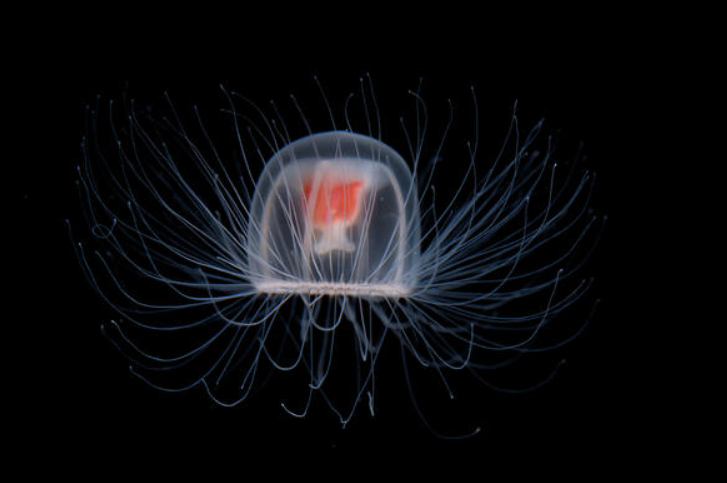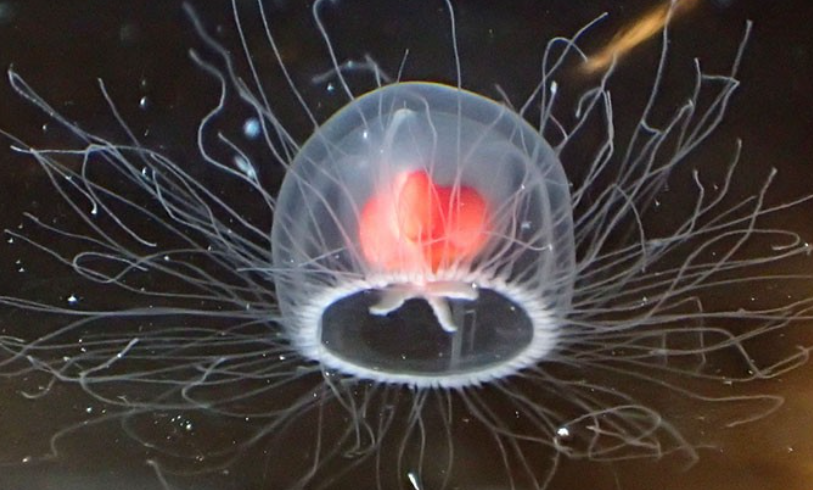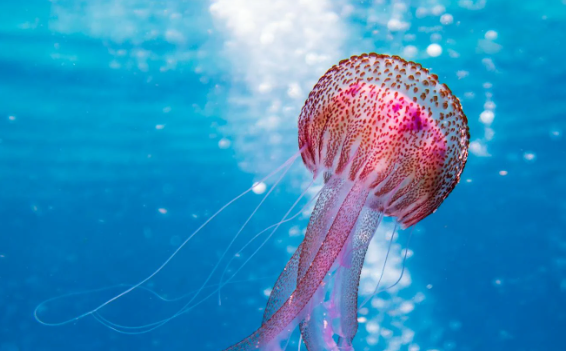These Immortal Jellyfish Live Forever by Regeneration

© Takashi Murai / The New York Times Syndicate
Ready to take a deep dive into the ocean? Well, if you are afraid of what you can see in the deep sea, we have got you covered! There is no need for you to splash and dive anymore, as we have all the information you will need around one majestic deep-water creature. And that is the Immortal jellyfish. But, is it really immortal? And what actually makes it immortal? Let us find out together!
What Is an Immortal Jellyfish?
The “immortal jellyfish” is a common name for a species of jellyfish called Turritopsis dohrnii. What makes this jellyfish unique is its ability to revert its cells back to their earliest form and start its life cycle anew. In essence, it can reverse aging and transform itself from an adult medusa (the mature, reproductive stage of a jellyfish) back into a polyp (the juvenile, non-reproductive stage).
This process is known as transdifferentiation, and it allows the jellyfish to escape death and achieve biological immortality. In the right conditions, Turritopsis dohrnii can go through this cycle repeatedly. This lets them live indefinitely under the right circumstances.
Why Is It Immortal?
Most jellyfish species follow a typical life cycle: eggs and sperm are released, and fertilization occurs, resulting in free-swimming larval forms. These larvae find a surface to establish themselves and grow into polyps. They then bud off and develop into young jellyfish. Adult jellyfish are called medusas, and they belong to the Cnidaria group alongside sea anemones and corals. Despite the typical life cycle, one jellyfish species, Turritopsis dohrnii, has the unique ability to revert its cells, potentially achieving biological immortality.

The immortal jellyfish due to its unique ability, can reverse its life cycle when physically damaged or stressed. Instead of dying, it shrinks, reabsorbs its tentacles, and settles as a cyst on the seafloor. Within 24-36 hours, it transforms into a new polyp, matures, and eventually buds off as a medusa, restarting its life cycle. This remarkable ability is compared to a butterfly transforming back into a caterpillar and then metamorphosing into an adult butterfly once again.
What Research Has to Say for Its Immortality
New research from the Universidad de Oviedo in Spain, published in the journal Proceedings of the National Academy of Sciences (PNAS), suggests that the immortal jellyfish, Turritopsis dohrnii, possesses twice as many copies of genes linked to repair and protection compared to its mortal relative, the crimson jellyfish Turritopsis rubra. The study explores the genetic factors associated with the unique rejuvenation ability of Turritopsis dohrnii, emphasizing variations in genes related to replication, DNA repair, telomere maintenance, redox environment, stem cell population, and intercellular communication. The findings may contribute to unraveling the mystery of the jellyfish’s biological immortality.
Medical Research on Immortal Jellyfish
Research on the immortal jellyfish has primarily focused on its unique ability to revert its cells and its potential implications for the study of aging and regeneration. This research was more within the realms of marine biology, evolutionary biology, and ecology rather than direct medical applications. The jellyfish possesses mutations that preserve telomeres, DNA sequences safeguarding chromosome ends that typically shorten with age, according to New Scientist.
Researchers highlight the importance of multiple molecular pathways contributing to the jellyfish’s immortality. Molecular biologist Jan Karlseder emphasizes the need to explore various pathways for healthspan extension. While human immortality is unlikely due to species differences, the study aims to provide insights into aging-related diseases. Co-author Maria Pascual Torner notes the research may inspire regenerative medicines by understanding jellyfish genes.
Immortal Jellyfish and Parkinson’s Disease
The unique abilities of certain jellyfish species, such as transdifferentiation, hold promise for advancing modern medicine. This process involves switching on and off genes in cells, offering potential applications in curing diseases. For example, reprogramming cancerous cells into healthy tissue could provide an alternative to traditional treatments like drugs or radiotherapy.
Similar approaches might be explored for neurodegenerative diseases like Parkinson’s and Alzheimer’s. The implications extend to treating injuries and cell enhancement. Despite the potential, understanding how jellyfish achieve these feats and whether they can be replicated in humans poses significant challenges due to genetic complexity and differences between jellyfish and humans.

Immortal Jellyfish Fun Facts
Here are some fun facts about the remarkable species:
1. Lifespan
It can theoretically avoid death and aging, letting it live forever under the right conditions. While the term “immortal” is used colloquially, it’s important to note that the actual lifespan of individual Turritopsis dohrnii jellyfish can be influenced by various factors. In the wild, they still face threats such as predation, disease, and environmental changes, which can impact their overall lifespan. Additionally, the exact conditions under which they can undergo transdifferentiation may not occur regularly.
2. Reproduction
The reproductive process of the Turritopsis dohrnii, or “immortal jellyfish,” follows a typical jellyfish life cycle but is unique for its ability to revert to an earlier stage. The life cycle begins with the release of eggs and sperm by adult medusae (the mature jellyfish). This release often occurs in response to environmental cues or triggers. The released eggs and sperm combine in the water, leading to fertilization. The fertilized eggs develop into free-swimming larvae that move with the ocean currents. The larvae settle on a suitable substrate and transform into stationary polyps. The polyps attach themselves to a surface, such as the seafloor or a substrate, and start to grow.
3. Habitat
The immortal jellyfish is a species found in various temperate and tropical oceans around the world. They are known to inhabit both shallow and deep waters, and their distribution can be widespread. Specific regions where it has been observed include the Mediterranean Sea, the waters of Japan, Spain, Panama, and the Atlantic Ocean. These jellyfish are often found near coastal areas, but their exact habitat can vary.
4. Late Bloomers
The immortal jellyfish was initially identified as a species in 1883. However, it wasn’t until the 1990s that scientists unveiled its extraordinary capabilities. This jellyfish gained widespread attention due to its unique ability to revert its cells and essentially achieve biological immortality. Discovered and described more than a century ago, the species remained relatively unremarkable until recent decades when researchers delved into its fascinating life cycle and its potential implications for the study of aging and regeneration in other organisms.
5. Oldest Immortal Jellyfish
Figuring out how old wild animals are can be tricky, usually relying on guesses from those in captivity or labs. And when it comes to immortal jellyfish, it’s a whole other challenge. These jellyfish are hard to keep in captivity, and not many have succeeded. In fact, only one biologist from Japan has managed to maintain a colony for a longer time. So, figuring out the age of these seemingly ageless creatures is a real puzzle, made even tougher by the fact that they can basically hit the reset button on their life cycle.
6. No Sexual Preference
Unlike most species that maintain consistent reproductive methods, immortal jellyfish exhibit unique characteristics in their life cycle. During the polyp phase, they reproduce asexually through a process called budding. This involves the continuous regeneration of cells in a specific area, leading to the formation of growths or “buds” that break off and develop into new offspring. In the medusa or adult phase, immortal jellyfish switch to sexual reproduction. They release sperm and eggs into the surrounding water, where fertilization takes place through spawning, contributing to the diversity of their reproductive strategies.
Endagerment and Conservation
The conservation status of jellyfish, in general, is not extensively tracked compared to many other marine species. Jellyfish are highly adaptable to various environmental conditions, and certain species, including Turritopsis dohrnii, can be found in different parts of the world.
Conservation efforts for marine species often focus on broader ecosystems, such as coral reefs and ocean health, as these efforts indirectly benefit a variety of marine life, including jellyfish. Factors like pollution, climate change, habitat degradation, and overfishing can impact marine ecosystems, potentially affecting jellyfish populations.
Do you think immortal jellyfish could be the key to immortality in humans as well?
You might also want to read: Breathtaking Facts You Never Knew About Jellyfish



